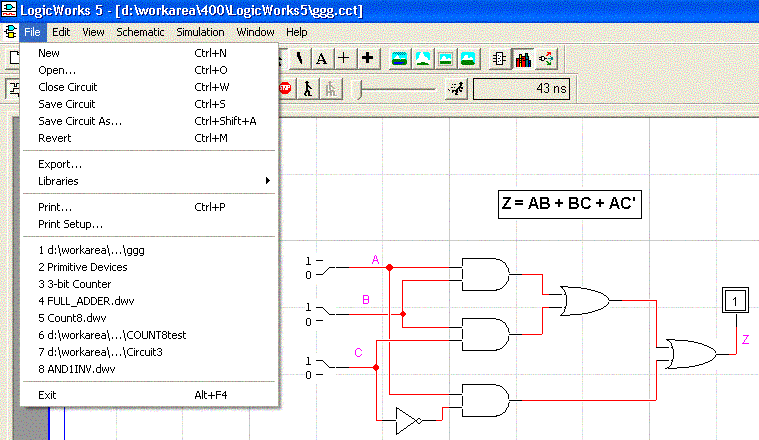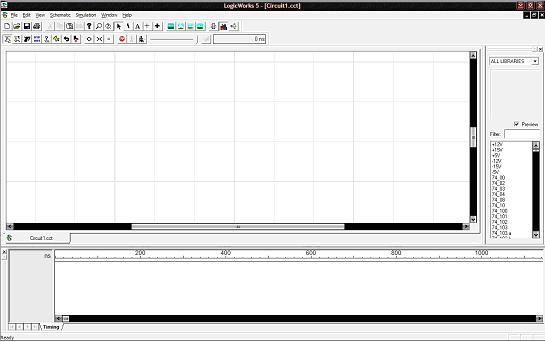Objective
This tutorial will show you how quickly you can create and test a circuit using LogicWorks.
Logicworks partnered with NextGate, a global healthcare enterprise identification software. NextGate is the only provider of a fully-managed, SaaS-based Enterprise Master Patient Index (EMPI) platform that runs on AWS. EMPI platforms are critical for hospitals and healthcare providers who need to quickly and accurately distinguish a patient’s. LogicWorks has been incredible to work with - a sophisticated, trustworthy, collaborative and flexible partner. Our needs were complex, and they went above and beyond to identify, discuss and create what we needed, even when that ultimately took different forms than originally expected, and required far more effort from them than either of us anticipated. LogicWorks: Software Distribution and Documentation LogicWorks Info & Libraries: LogicWorks HomePage; LogicWorks patch to latest version from LogicWorks. LogicWorks in ECE computer lab: lwece.pdf (13Jan00) When you save the below library files, be sure that they still have the.clf extension.

- Start LogicWorks 4 by selecting it from the Start menu. You should see three windows pop up.
The window on the top left of the screen is called the design window. This has LogicWorks4 - [Circuit1.cct] written on its title bar. This is where we will draw the circuit to be simulated. The window on the right is called the partspallette and the window below the design window is called the timing window. - Go to the partspallette. Select the drop-down list at the top. Choose Simulation Gates.clf from the options in the list. Now you should see a listing of various gates in the lower part of the partspallete.
- Double-click on AND-2 and move the mouse pointer (cursor) into the design window. You should have a blinking AND gate in place of the pointer now. Position the AND gate in the middle of the design window. Left-click once to place it on the schematic. (You can place as many AND gates as you want simply by moving to a clear location and clicking.)
- Now go to the partspallette and select the drop-down list. Choose Simulation IO.clf. You should see the listing change.
- Double-click on Binary Switch and place two of them on the schematic near the inputs of the AND gate. Make sure the switches have sufficient distance between them and do not overlap.
- Double-click on Binary Probe and place a probe near the output of the AND gate.
- Go to the Drawing toolbar and click on the left plus (+) sign[don't use the right plus(bold +) sign]. Move the pointer to the design window. The pointer should change to a cross (X) sign. You are now in wiring mode. To connect two pins, click on one of them and then click on the other. They should now be wired together. (Note: any time you want to return the cursor to a pointer, just press the Spacebar.)
- Connect one of the switches to the upper input of the AND gate and then the other switch to the lower. Now connect the output of the AND gate to the probe. If you have connected the parts properly, the probe should display a binary number in place of the X it had before it was connected.
- Troubleshooting:If the probe displays an X, click on the wires to verify the connections. The wires are connected to whatever is highlighted.
- If there is a problem, go to the Drawing toolbar and click on the lightning bolt. Move it to the design window and zap the questionable connection to erase it. Now reconnect the pins and verify.
- You will need to name the signals to see the simulation results in the timing window. To name a signal, go to the Drawing toolbar and choose the text tool, A. (Alternatively, in the design window, go to the Edit menu and choose Text. The pointer changes to a pencil. Place the pencil point on the output wire of the AND gate and click once. The pencil will change to anI-beam. Type the output signal name and Enter. You should see the signal name colored magenta and appear in the timing window as well. If it didn't, you just entered a black colored label (i.e., text), not a name. (You can zap mistakes at anytime.) Similarly, name the two input signals. (You can use the pointer to move the names to their final positions.)
- You are now ready to run the simulation. In the design window, go to Simulation toolbar and click on the walkingman button. Now go to the design window and click on one of the switches. Repeat this a few times and observe the results in the timing window. Do the results make sense? Do the same thing with the other switch. If you have problems seeing the output clearly, push the < > button on the simulator toolbar a few times until you are comfortable with the display.
If required to hand in a deliverable, follow the following steps.
You are ready to save your circuit and print it out. Before you do, there are two things you need to do.
1. Put the circuit name, your name and the date on the circuit drawing. You use the text tool as before except you can write in any empty area on the schematic. Right-click on the label to get the Text Object Options box. Select Draw Frame Around Text. Click on Font Specs. Change the font Style to Bold and Size to 14.
2. Center your drawing on the page. In the design window, go to the Schematic menu and choose Center in Page. Go to Design Preferences and set Show Printed Page Breaks to see that your drawing fits on a single sheet. In the File menu, use Print Setup to choose the orientation of the printer paper you want. Print your circuit. Save your circuit on your own floppy or in your own account disk space. (Caution: the lab PCs are initialized periodically and your files will be erased.)
LogicWorks(TM) Lab 4
Logic Simulation of Circuits with Feedback
1. Tutorial Objectives
In this laboratory, you will gain experience in using LogicWorks(TM) to simulate latches, flip-flops, and some simple shift register circuits. In particular, you will:
* Simulate ring oscillators constructed from inverter chains.
* Simulate R-S and - latches constructed from cross coupled NOR gates and NAND gates respectively.
* Simulate a master/slave J-K flip-flop.
* Simulate positive and negative edge-triggered D flip-flops.
* Construct a two element shift register and determine the conditions under which the introduction of clock skew leads to incorrect results.
* Understand the limitations of the software simulator for simulating circuits with feedback, particularly for modeling race conditions, and how to establish initial conditions for the simulator.
Look back at Lab One if you need to review the use of LogicWorks(TM). It will be useful to remember how to use the Device Editor introduced there.
2. Getting Started: Ring Oscillators
1.Begin by invoking LogicWorks(TM), and create a schematic with three inverters in series.
2.Feed the output of the last inverter stage back as an input to the first stage.
3.Place probes at the outputs of the three inverter.
4.Label the outputs of each inverter by the labels A, B, and C respectively..
What value do they read out?
The simulator must commence its operation making some assumptions about the initial values of all circuit nodes.
LogicWorks(TM) understand the values
·logic 0,
·logic 1,
·undefined ( 'X' ),
·as well ( 'Z' ).
Initialize the simulation
In the absence of other information, LogicWork assumes that all circuit nodes are undefined. One way to initialize the simulation to a known state is to use the Select All under Edit then Clear Unknowns command under the Simulation menu. Do this now.
Logicworks Glassdoor
1.What happens to the values displayed on the probes?
2.Is this an inconsistent starting state for the simulation?
3.If so, why?
While clearing the unknowns using the simulator command certainly has its uses, it is better to explicitly place the simulation in a known state. By the way, this is also a good idea in real hardware: at power up, a hardware system can (and as Mr. Murphy would said, will) come up in an unexpected or inconsistent state.
Place the simulation in single step mode. The simplest way to initialize the simulation is to specify starting waveforms in the timing window that are consistent. Do this then place initial values on A, its complement on B, and B's complement on C by selecting a line and right clicking. Choose attributes then InitialSig and place value in box and check visible.
4.What waveforms are displayed in the timing window?
Run, Watch the values as they pass through the probes. If you see an 'X' value that persists, you have not succeeded in correctly initializing the simulation. Single step the simulation if you are having difficulties following how the values change. It is not inconsistent in a running simulation for the input and output of an inverter to have the same value.
5.Why is this?
Set duty cycle
6.What is the period of the output waveforms, i.e., how many time units are there between adjacent rising edges?
7.What is the duty cycle of the waveforms, i.e., the percentage of time that the waveform is high versus low during its period?
8.How wide, in time units, is the high time of the waveform?
It may be difficult to answer these questions because LogicWorks(TM) assumes unit delay, that is, each gate has a delay of one time unit. Go back and increase the gate delays to ten time units for each inverter. (Reminder: to do this, first select the gate, then select the Set Params command under the Simulation menu, and finally fill in 10 in the delay box.)
9.Now what is the period, duty cycle, and high time of the waveforms?
Extend the circuit to five inverters in a chain.
If you changed the delay of the inverters in the preceding paragraph, don't forget to follow the same process for the inverters you are now adding to the chain. You will probably need to reset the timing and re-initialize the simulation to get it into a consistent starting state.
10.What do the waveforms look like now?
11.What is the relationship between the number of gates in the chain and the shape of the waveform?
Clock
Under the Generic Devices submenu of the Libraries menu, you will discover a useful device called clock. Select this and place it on your schematic. Put a probe on its output and label it CLK. Select the device and then Select Params under the Simulation menu. LogicWorks(TM) allows you to set the high and low times of your clock. By default it has a period of 20 time units with a 50% duty cycle (i.e., high time of 10 time units, low time of 10 time units). Experiment with different settings and verify through simulation that the clock generates the waveform you specified.
3. R-S and Latches
With LogicWorks(TM), draw two cross-coupled NAND gates and two cross coupled NOR gates. Places switches at the inputs and probes at the outputs. Call the outputs Qnand, ,Qnor, and , and the inputs In1, In2, In3, and In4 (as shown in Figure 1)
.
Figure 1
What are the initial values read out on the probes? Do they include don't cares? If they do, place the latches in a consistent initial state. Now try all input combinations and write down your observations in a table format.
In terms of setting and resetting the outputs,
what function is formed by driving
1.In1 low (to 0)?
2.In2 low?
3.In3 high (to 1)?
4.In4 high?

5.Under what conditions are the outputs, supposedly complementary, driven to the same values?
6.Circle these 'forbidden' states in your table.
7.Under what conditions do the latches hold their previous values?
8.Typical setting means forcing a value to 1 and reset means forcing it to 0. Rename your inputs S for the input which performs set and R for reset.
9.Describe what is meant by race conditions. (It is not possible to observe the race condition inherent in latches implemented as above when using the input switches. Both inputs must change simultaneously to trigger the race.)
“level sensitive” latch
For the rest of this laboratory, we will be using the R-S latch to build other kinds of building blocks. Create the following “level sensitive” latch and built from a copy of the RS latch.
10.How does this behave compared to the RS latch?
11.Can it change state back and forth while the CLK input is at logic 1


12.Are set and reset active high or active low?
Make level-sensitive D-latch from level-sensitive RS-latch by connecting S = D and R = not D.
1.How does this latch behave? (give a table)
2.Describe why this configuration avoids the 'forbidden state' problem.
Logicworks Software
4.Master/Slave Edge-triggered Flip-flop
First, construct a flip-flop using the D latch as a building block.
1.What is the behavior of this flip-flop?
2.Does this value of Q at time t+1 depend on Q at time t?

3.What does it depend on?
4.Explain how the master slave configuration and making the flip-flop edge-triggered, makes certain that we can precisely control the moment when all flip-flops will change state.
5.If this were built with R-S latches instead of D latches (an RS flip-flop) how would feedback from slave to master help avoid the 'forbidden state' problem?
5.Toggle Flip-flops
Build the following flip-flop where D-latch is a copy of your level sensitive latch above.
1.What is the behavior of this flip-flop?
2.determine what happens when J and K are both 1
Factoid: Ripple Counter
Logicworks Careers
In the 4-bit counter to the right, we are using edge-triggered master-slave flip-flops similar to those above. The output of each flip-flop changes state on the falling edge (1-to-0 transistion) of the T input.
The count held by this counter is read in the reverse order from the order in which the flip-flops are triggered. Thus, output D is the high order of the count, while output A is the low order. The binary count held by the counter is then DCBA, and runs from 0000 (decimal 0) to 1111 (decimal 15). The next clock pulse will cause the counter to try to increment to 10000 (decimal 16). However, that 1 bit is not held by any flip-flop and is therefore lost. As a result, the counter actually reverts to 0000, and the count begins again.
Logicworks Stock
A major problem with the counters shown on this page is that the individual flip-flops do not all change state at the same time. Rather, each flip-flop is used to trigger the next one in the series. Thus, in switching from all 1s (count = 15) to all 0s (count wraps back to 0), we don't see a smooth transition. Instead, output A falls first, changing the apparent count to 14. This triggers output B to fall, changing the apparent count to 12. This in turn triggers output C, which leaves a count of 8 while triggering output D to fall. This last action finally leaves us with the correct output count of zero. We say that the change of state 'ripples' through the counter from one flip-flop to the next. Therefore, this circuit is known as a 'ripple counter.'

Comments are closed.